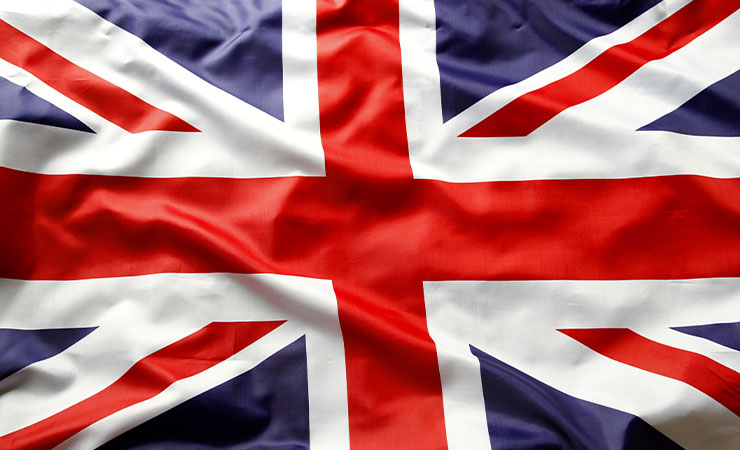The flag of the United Kingdom is called “the Union Flag“, commonly known as “the Union Jack“, and the current design has been used since 1801 and has remained unchanged. The flag consists of three colours: red, blue, and white, symbolising the different “countries” of the United Kingdom, which is called the United Kingdom of Great Britain and Northern Ireland because it is made up of different Kingdoms, which, as you know, these “countries” are England, Scotland, Wales and Northern Ireland.
The Union Jack is more than just a graphic design; it carries a lot of historical and cultural meaning. The flag is a combination of the flags of England (the red cross of Saint George), Scotland (the white saltire of Saint Andrew on a blue background), and Ireland (the red saltire of Saint Patrick). Note that Wales is not represented in the Union Jack, as it was already united with England before the creation of the flag. Each country in the United Kingdom has its own patron saint, and each patron saint is celebrated with a national day every year.
Why is it Called the Union Jack?
Union
The term “union” is easy to understand, referring to the union of multiple kingdoms that make up the United Kingdom. This designation reflects the historical and political merger of these regions, particularly after Ireland joined Great Britain in 1801, forming the United Kingdom as we know it today.
Jack
The term “Jack” is widely understood in naval terminology to refer to the flag flown at the bows of a ship. Historically, British warships would hoist the national flag at the bow while underway as a clear sign of their nationality. Another theory traces the word “Jack” back to King James I. In 1606, he decreed the creation of the first flag representing Great Britain. At the time, this emblem was simply referred to as the “British flag” or the “flag of Britain”; the royal proclamation did not bestow it with a distinctive name. At James I’s funeral in 1625, however, the flag was called the “Banner of the Union of the two Crosses of England and Scotland.” The word jack, meaning a maritime bow flag, was already in use by the 1600s—but by 1674, although its formal title was “His Majesty’s Jack,” it was informally known and officially recognised as the “Union Jack.” Thus, the “Union Jack” came to be understood as the naval flag of the United Kingdom, and over time the term also became common in non-naval contexts—reflecting the deep influence of maritime culture in British history.
United Kingdom Flag Composition and Meaning
England

The cross flag used in England is the “St George’s Cross“. Born in Palestine around 260, St George was originally a Roman knight who was canonised as a Christian saint after he died, preventing the persecution of Christians by the Roman Emperor Diocletian.
In European mythology, there was an evil dragon by the sea in Libya, and the people feared the dragon’s power and paid him an annual tribute of beautiful maidens as sacrifices. When St George, a knight, travelled to the region, he was so displeased with the dragon’s brutality that he swung his sword and killed the dragon, whose blood flowed onto the ground in the shape of a cross.
In 1190, during the Third Crusade, Richard the Lionheart of England led the army as a general and won a great victory in Acon. According to legend, the place where St George slayed the dragon was near Acon, so the English believed that St George blessed their victory and henceforth honoured him as their patron saint, and the St George’s Cross flag became the flag of England.
Scotland

The flag used in Scotland is also known as the “St Andrew’s Cross”. St Andrew was one of the twelve disciples of Jesus. The Bible tells us that he was a fisherman on the shores of the Sea of Galilee and that after the ascension of Jesus, he spread the Gospel in several countries along the Mediterranean Sea. However, there was a great persecution of Christianity in the early Roman Empire, and St Andrew was captured and executed in Patras, Greece.
Legend has it that before he was martyred, Andrew asked the Roman authorities not to let him be crucified on the cross in the same position as Jesus, and the Roman authorities passed on his request; after that, St Andrew was executed on the cross. The crossed cross later became the symbol of St Andrew.
In 832, Angus II, King of the Picts of Scotland, led an army against the Kingdom of Northumbria. When Angus’s army was besieged, Angus II asked the monks to pray for divine providence, and then he saw the white clouds in the sky forming the shape of the Cross of St Andrew and swore an oath that if St Andrew helped him to win the war, then St Andrew would become the patron saint of Scotland. After the victory, the flag of St Andrew’s Cross became the national flag of Scotland.
Ireland

The Red Cross in Ireland is also known as the “St Patrick’s Cross”. St Patrick was born in the British Isles around 386 and was sold into slavery in Ireland as a boy. After escaping from Ireland, he became a Christian and considered returning to Ireland as a missionary. 432, St Patrick was sent to Ireland by the Pope and remained there for the rest of his life, building churches and schools to educate the people, thus making St Patrick the patron saint of Ireland.
King George III of England created the Most Illustrious Order of Saint Patrick in 1783, with a red cross from the coat of arms of noblemen such as Fitzgerald or the Duke of Leinster.
After the creation of the Order of St Patrick, the red cross became known as the St Patrick’s Cross, and the St Patrick’s Cross became the symbol of Ireland.
Wales

The Welsh flag is white in the upper half, green in the lower half and a red dragon in the centre. The Queen officially designated this flag as the national flag of Wales in 1953, but the cult of the dragon in Wales has a much longer history.
Legend has it that during the reign of King Luthor, every year in May, a terrible cry would be heard that would bring disaster. King Luthor turned to his brother Levar for help and learnt that the noise was caused by two red and one white dragon fighting. King Luthor put the dragons in a coffin, and some years later, King Vortigern dug up the two dragons, who woke up to fight again, ending with the red dragon chasing away the white dragon. Merlin, who was seven years old then, prophesied that the white dragon represented the Saxons and the red dragon represented Wales. The red dragon would eventually defeat the white dragon, meaning the Welsh would finally repel the Saxons.
In 1485, Henry VII, a Welsh royal, succeeded to the throne and won the war, and since then, the red dragon has often appeared on the royal coat of arms.
The Union Flag

Ultimately, the UK flag combines the flags of England, Scotland, and Northern Ireland. But you’ll notice why the Welsh flag shown above isn’t included. There is no Welsh flag because since Edward I took Wales in 1282, according to the Wales Acts 1535 – 1542, England and Wales were united, so when you look at the news reports, they all say England and Wales together as well.
The English flag is not symmetrical, with the broad white stripes above the red stripes on the side attached to the flagpole and below the red stripes on the side away from the flagpole. This is because if the St Patrick’s cross were centred, the St Andrew’s cross would look like the border of the St Patrick’s cross, and the white stripes have been widened to emphasise the relative positions of both the St Patrick’s cross and the St Andrew’s cross at the same time. Also, because Scotland joined Great Britain before Ireland, the St Andrew’s Cross is higher than the St Patrick’s Cross on the side near the flagpole.
English Flag vs. British Flag
The English Flag is the red cross of Saint George on a white background, representing England only. The British Flag, officially the Union Flag or Union Jack, represents the entire United Kingdom and combines elements from the flags of England, Scotland, and Ireland, but not Wales.
FAQ
The term “Union Jack” originated from using flags on British naval ships in the 17th century. It was initially called the “Union Flag,” but when flown at sea, it was known as a “Jack.” Eventually, people started referring to it as the Union Jack and the name stuck.
The current design of the UK flag was officially adopted in 1801 after Ireland joined the union with Great Britain. It replaced the previous version, which only included England and Scotland’s crosses.
Yes, each colour in the UK flag holds significance. The red represents England and courage, the white represents Scotland and purity, and the blue represents Ireland and loyalty.
The upside-down Union Jack is a traditional British distress signal originating from the navy, used to indicate an urgent call for help; today, it may also serve as a symbol of protest, and displaying it inverted in formal settings is seen as a serious error.
The design features:
England – St George’s Cross (red cross on white)
Scotland – St Andrew’s Cross (white diagonal cross on blue)
Ireland – St Patrick’s Cross (red diagonal cross on white)
When the first Union Flag was created in 1606, Wales had already been annexed by England in the 16th century, so it was considered part of England and given no separate representation.
No, the Union Jack is not symmetrical. The white diagonal stripes are offset, so there is a correct way up and a wrong way up.
The Union Flag represents the United Kingdom. The Royal Standard is the monarch’s personal flag and is flown only when they are present at a location.








